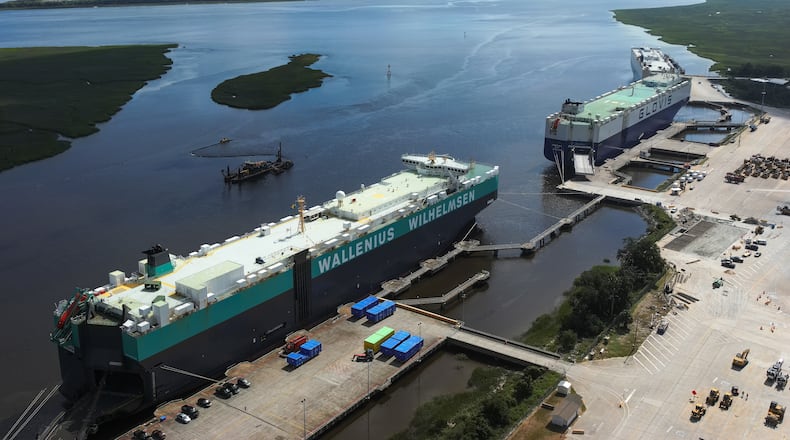BRUNSWICK ― The Georgia Ports Authority has done everything within its power to successfully turn the Port of Brunswick into the nation’s busiest for automobiles and heavy equipment cargo. It has expanded the terminal’s acreage, contracted with a highly efficient group of dockworkers and eased accessibility with links to rail and I-95.
The one vital infrastructure piece outside the Ports Authority’s control — the federally managed Brunswick River shipping channel — threatens the port’s supremacy.
Officials learned in January that approved and funded dredging work, known as the Brunswick Harbor Modification Project, would not move forward this year as planned. Contractor bids to deepen and widen the river channel all exceeded the funds budgeted, delaying the $17.3 million project indefinitely, the U.S. Army Corps of Engineers told Ports Authority leaders.
The postponement comes as Brunswick has overtaken the Port of Baltimore as the nation’s leading port for wheeled and tracked equipment, known in the industry as roll-on, roll-off — or RORO — cargo. Brunswick’s Colonel’s Island facility handled 2.1 million tons of cars, tractors, bulldozers and other farm and construction equipment in 2024, Ports Authority CEO Griff Lynch reported Wednesday at the annual Brunswick State of the Ports luncheon at the Jekyll Island Convention Center.
Lynch told those in attendance he is confident the project will be completed by 2027, when a fourth ship berth is to open at the Brunswick port and bring an additional two vessel calls per week. The port’s three existing berths currently combine to average 11 ships each week.
“We need support,” Lynch said. “As the No. 1 terminal in America, the federal government needs to pay attention.”
Credit: Courtesy of Georgia Ports Authority
Credit: Courtesy of Georgia Ports Authority
Brunswick’s plight has drawn the interest of an influential advocate. U.S. Rep. Mike Collins (R-Jackson) chairs a House subcommittee devoted to waterways, and he’ll visit Brunswick on Monday to tour the port terminal and ride aboard a vessel as it navigates the channel leading to and from the docks.
In a telephone interview Thursday, Collins pledged to take the knowledge he gleans from the Brunswick trip back to Capitol Hill and find a solution for the dredging issue.
“I’m not one of those guys who wants the gavel and just rides,” Collins said. “We came to work.”
Credit: Arvin Temkar/AJC
Credit: Arvin Temkar/AJC
Another lawmaker, U.S. Rep. Buddy Carter (R-St. Simons Island), has also pledged his support. “As our region continues to expand, it is critical that we move quickly to deepen the Brunswick Harbor so that we can adequately prepare for this growth,” he said in a statement shared by a spokesperson.
Carter’s district stretches the length of the Georgia coast, and Georgia’s ports have been a priority of his since he was first elected to Congress in 2014. Port facilities in Brunswick and Savannah support 561,000 jobs and contribute $59 billion annually to the state’s gross domestic product, according to a study by the University of Georgia.
U.S. Sens. Jon Ossoff and Raphael Warnock have been pushing for months for the dredging to move forward. In a joint letter Monday to the Army and Army Corps of Engineers, they said they “continue to be alarmed by the failure to award this project” and the “costly project delays that will result from this collective failure.”
The Brunswick shipping channel stretches 15 miles from the port to the Atlantic Ocean and is supposed to measure 38 feet deep and 500 feet wide. But the river hasn’t met those specifications since 2010, three years after the most recent deepening.
Almost 2 miles of the channel has narrowed to about 200 feet while some 4 feet of silt and sediment has accumulated on the river bottom. Deep draft vessels or those heavily loaded with cargo must wait until high tide to access the port.
With shipping companies now building larger-capacity vessels to increase profitability and reduce their carbon footprint, the Brunswick port’s limitations will become more pronounced in the years ahead. One of the port’s biggest customers, Wallenius Wilhelmsen, plans to introduce RORO ships that can carry as many as 11,700 autos in 2027 and ride 5 feet deeper in the water than the 8,000-unit vessels that currently call on Brunswick.
“The channel is already a real problem,” said Bruce Fendig, the senior pilot of the Brunswick Pilots, who guide each ship into and out of the port. “The vessels that are coming are remarkably bigger than anything we are handling today, so we need the dredging done properly and the modification program completed.”
Funding isn’t the only complication ahead for the Brunswick deepening.
Sea turtle migratory patterns limit dredgers to a window of Dec. 15 to March 31 to do the work. Loggerhead turtles nest on Georgia beaches between May and late August. One popular egg-laying destination, Jekyll Island, flanks the shipping channel.
A government-owned dredge that could have performed the Brunswick modification this winter is undergoing repairs and will be in dry dock until after March 31.
Credit: NYT
Credit: NYT
The deepening challenges frustrate Georgia Ports officials, but they remain optimistic the situation will be resolved. They are prepping for continued growth in market share by adding the fourth ship berth and investing $100 million to expand rail infrastructure.
Brunswick manages more than 14% of all U.S. auto imports. Four third-party auto processing firms, handling vehicles from 18 automakers, operate out of the Brunswick terminal.
“We’ve put the infrastructure here for the autos,” said Kent Fountain, Georgia Ports Authority board chairman. “They can’t just move to another port.”
About the Author
Keep Reading
The Latest
Featured






